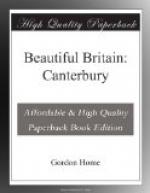Such austerity had hitherto been unknown to English saints, and the marvel was increased by the sight—to our notions so revolting—of the innumerable vermin with which the hair-cloth abounded—boiling over with them, as one account describes it, like water in a simmering cauldron. At the dreadful sight all the enthusiasm of the previous night revived with double ardour. They looked at one another in silent wonder, then exclaimed, “See, see what a true monk he was, and we knew it not!” and burst into alternate fits of weeping and laughter, between the sorrow at having lost such a head and the joy of having found such a saint.
[Illustration; the chapel of st. Michael or the warriors’ chapel. It is one of the most interesting Chapels in the Cathedral, containing the tomb of Stephen Langton and in the centre of the drawing that of Lady Margaret Holland and her two husbands.]
Almost immediately the superstitious belief in the efficacy of a martyr’s blood made everyone who was permitted to approach Becket’s body anxious to obtain a scrap of a blood-stained garment to soak in water with which to anoint the eyes! In a short time many parts of the clothes had been given away to the poor folk of Canterbury; but as soon as the miracle-working properties came to be properly understood these precious shreds of the Archbishop’s voluminous garments ran up in value until the possession of such a fragment meant wealth to the owner. Any relic of the body itself had still greater value, its efficacy in curing the multifarious ailments of the pilgrims who began to flock to Canterbury being immeasurable. And when the neighbouring monastery of St. Augustine burned with desire to possess a relic of St. Thomas they offered Roger, the keeper of the “Altars of the Martyrdom,” the position of Abbot of their own abbey if he would contrive to bring with him a portion of Becket’s skull. Roger had been specially chosen to guard this relic, but he succumbed to the temptation offered by the rival establishment outside the city walls, and having purloined the coveted fragment of the martyr, was duly installed in the highest office of St. Augustine’s. Whether the whole affair was public property at the time does not fully appear, but those who recorded events at St. Augustine’s did not hesitate to glory in the success of their scheme!




